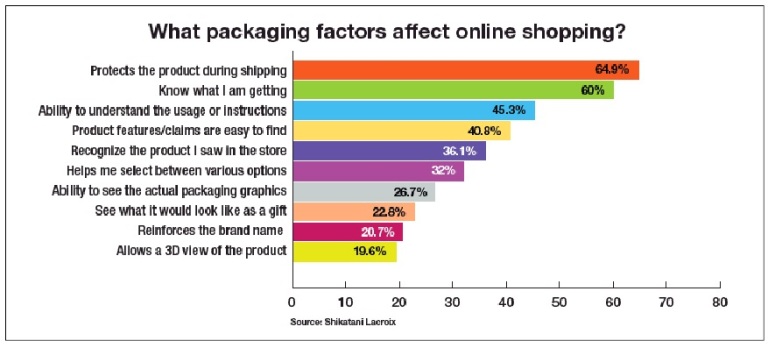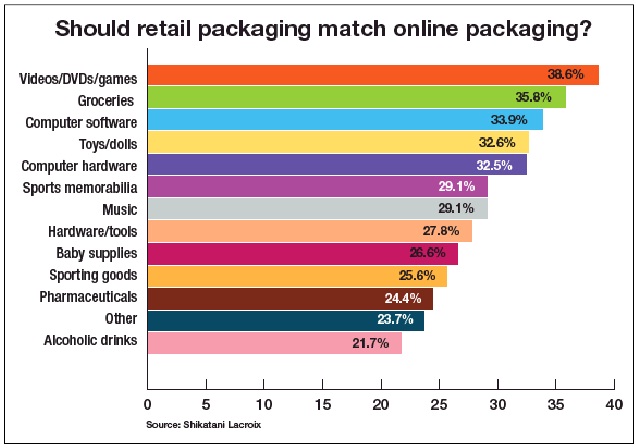The practice of purchasing products online has affected packaging-appearance, structure, messaging and more. However, research and expert opinion reflects there still exists a need for packaging companies to understand the differences-and those differences may not be as broad as one might think.

Dale Doyle, creative director of brand/design consultancy firm Landor Associates, says understanding how packaging and online consumer behavior interrelate is key, and it presents a number of opportunities for brand owners.
"Online shopping is a huge behavior change for the consumer, and I believe we're still in the infancy stage of figuring out how best to communicate the brands we develop to the consumer via the Internet," he says. "We need to work harder to communicate our story, not only on-pack, but the space around the package on the site."
In November 2011, brand/design consulting firm Shikatani Lacroix released "Packaging in an online world," a white paper that examined how packaging influences consumer behavior (and vice versa) as it relates to shopping via the web. Among the findings related in the document:

A number of factors can influence whether or not shoppers seriously consider or purchase a product. Among the most important reasons: getting a view the actual product packaging, knowing the product's packaging will protect it during shipping and knowing the product packaging presented online communicates precisely what they'll be getting when they open the container at home.
Receiving the same packaging at home that one would find in a retail store is more important in certain categories than others. When asked how important it was to have the product arrive in the customer's home in the same packaging seen in the post purchase, the CPG categories that ranked highest were pharmaceuticals (36.2 percent) and groceries (35.8 percent).
Shoppers often prefer that the packaging of products purchased online be the same as it would be if they purchased the item in the store. The level of their preference varies by category (see chart).

Also, according to Jean-Pierre Lacroix, president of Shikatani Lacroix, purchasing branded packed products indicates strengthened shopper loyalty. The research outlined in "Packaging in an online world" reflects that online shoppers are as much as 15 percent more brand loyal than shoppers walking retail aisles.
"Online purchases have become ritualistic as consumers migrate from retail stores to online experiences as they become familiar with brands, making it harder to switch consumers once they have purchased a brand online," he says. "Packaging in both online and retail share the need to scan a wide range of products and the need to connect in the blink of the eye remains critical. Online shopping has the benefit of not having cluttered shelves, giving each product greater differentiation. However, due to the resolution size, online packaging messaging needs to be simpler as much of the mandatory copy is hard to read online."
Doyle points out that the practice of shopping online is a different experience than retail browsing for a number of key reasons. First, he points out, consumers typically will connect with a product and brand for a longer span of time when sitting at home in front of a computer than when standing in a store. Also, brands have the option of leaving off all the legally required messaging that must appear on a pack sold in a store, leaving more room and freedom for incorporating graphics and text that further enhance the brand. Also, brand owners have more leeway to present the package graphically, as opposed to how the retailer opts.
"The beauty of the online environment affords the opportunity to put the package in context of a visual environment, as opposed to a cold, dull shelf, which helps with visual appeal," Doyle says.
It is important to grasp that when it comes to understanding the relationship between packaging and online shopping, conventional wisdom on consumer behavior can be off the mark. In January, PricewaterhouseCoopers (PwC) released "Demystifying the online shopper: 10 myths of multichannel retailing," a report that examines common misunderstandings of consumer behaviors and trends. According to PwC principal Ron Klein, one such misunderstanding is that online sales are sapping retail registers.
"There's a sense that online retail is cannibalizing retail sales," Klein says. "However, data shows that customers connect with brands in stores, and they are often likely to spend more money with that brand in that store."
Klein pointed out retail shoppers still can interact with the products they're seeing on shelves online. With smartphones and other digital devices, they can connect directly with the brand, learn deeper information about a product, price the item and find about offers-all while still in the store.
The 10 myths outlined in the PwC report are:
Social media will become an indispensible retail channel.
In the future, stores will be mere showrooms.
Tablets will overtake PCs as preferred shopping devices.
As the world gets smaller, global consumers will become more alike.
China is the future model for online retail.
Domestic retailers will always enjoy a "home field advantage" over overseas counterparts.
Global online-only retailers like Amazon will always have an advantage over domestic online-only companies.
Online retail is cannibalizing sales in other channels.
Low price is the main driver of customer spending at their favorite retailers.
Lacroix says that despite the changes that online shopping have created in consumer behavior, the shift has not motivated CPGs to dramatically change their packaging overall, adding that there are opportunites in that arena such firms could take advantage of.
"CPG companies need to view online retailers such as Amazon as their own class of trade more closely aligned to Cosco or Sam's Club where the product formats and basket sizes are larger," he says. "This provides a great platform to offer multipacks that take customers out of the market longer."
Lacroix points out that Amazon and other online retailers are offering branded secondary/shipping packaging. However, Shikatani Lacroix research indicates that the protective function of packaging in the shipping process tends to trump branding or other more conventional package design merchandising principles.
As with retail shopping, online shopped packages take sustainability into account. According to Doyle, the environmental friendliness of a product (tempered by cost) is important.
"Sustainability will continue to be an important aspect of packaging, both online and in-store for the near and far future," he says. "Cost plays a key role in how much companies are willing to invest and still be profitable."
Lacroix adds that while packaging companies and brands are seeing slimmed-down packaging, including with online products, packaging won't be disappearing completely anytime soon.
"We will always need packaging graphics to effectively communicate the products point of difference," he says. "However, there will be a shift to the type of packaging structures that consumers will accept once delivered to their homes. This shift will be driven by a familiarity of what to expect once the product is delivered in addition to pressure by municipalities to reduce landfill cost. Our research has shown that the physical package primary purpose is protection followed by ensuring the product purchased online matches the product delivered. This will drive a rethinking of secondary packaging."
Lacroix says packaging plays a larger role of influence in some categories than others. For example, research indicates that when products are purchased as gifts (such as perfume, gourmet chocolates or other items), consumer behavior indicated packaging plays a more functional role.
Lauren Licata, interactive marketing specialist with branding and design firm Kaleidoscope, says designing packaging that performs well online requires starting with the right questions. "When a brand comes to us with a package design project, it's always important to understand the environment where the product will be sold," she says. "In a retail environment, for example, it's crucial that the package graphically communicates, ‘Who am I?' and, ‘Why am I right for you?' in order to encourage purchase at shelf. The package structure, on the other hand, may need to provide protection or even act as a delivery system."
Doyle says that customized and custom-look packaging can appeal to online shoppers. His firm recently partnered with Stride, a Kraft Foods brand, on iD Gum, which features strong, striking graphics.
"There are 18 unique illustrations over three different flavors that will shift as the brand grows, keeping the brand engaging and fresh," he says. Such graphics present strongly online, which can help convince Internet shoppers to buy.
Licata adds that graphics are important to online shoppers, but influence on consumer behavior doesn't stop with a pretty package.
"Many consumers consider online reviews, product descriptions, and product images and may never actually see the package prior to purchase," she says. "While packaging overall may become less important at purchase in an online shopping environment, it can play a crucial role during shipping and consumer delight upon delivery."
Licata adds that structure of packaging is of high importance in the shipping, pointing out that the graphics, marketing materials, overall presentation and sequence of opening/unwrapping packaging upon receipt can play a role in impacting consumer experience and reaction. As Lacroix pointed out, some retailers, such as handbag manufacturer Coach or clothing purveyor Rue-La-La, use the outer shipping carton, branded tissue and embossed receipt envelopes to enhance the brand and create a premium experience through packaging.





